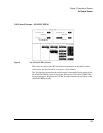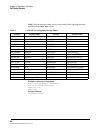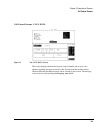
93
Chapter 3, Description of Screens
Call Control Screens
Querying Multiple Fields With Single OUTPUT/ENTER When multiple queries are
combined into one command string the Test Set responds by sending one response mes-
sage containing individual response message units separated by a response message unit
separator (;).
Example of Multiple Queries Combined Into One Command String
OUTPUT 714;"CALLP:MESS ’SPC WORD1’"
OUTPUT 714;"CALLP:SPOM1:DCC?;SID?;OHD?"
ENTER 714;Message$
PRINT Message$
Printed Test Set Response Message
"01";"00000001110011";"110"
In order to read individual response message units into individual string variables com-
bined into one ENTER statement the programming language used must recognize the
response message unit separator (;) as an entry terminator for each string in the input list.
If the programming language used cannot recognize the response message unit separator
(;) as an entry terminator then the response message must be read into one string and indi-
vidual responses parsed out.
Modifying the CALL BIT Screen Message Fields
This section provides
programming information on how to set the contents of individual fields in the
signaling messages available on the
CALL BITS screen.
The syntactical structure for setting the contents of a field in an individual
message is as follows:
General Syntax’
CALLP:<message name>:<field name><space><’><data string><’>
Table 3, "CALL BIT Screen Signaling Message Names" on page 92 lists the
message names used to access each of the signaling messages available on the
CALL BIT screen.
Example of Modifying A Single Field
OUTPUT 714;"CALLP:SPOM1:SID ’00000001110011’"
Example of Modifying Multiple Fields With One OUTPUT
OUTPUT 714;"CALLP:SPOM1:DCC ’01’;SID ’00000001110011’;OHD ’110’"


















